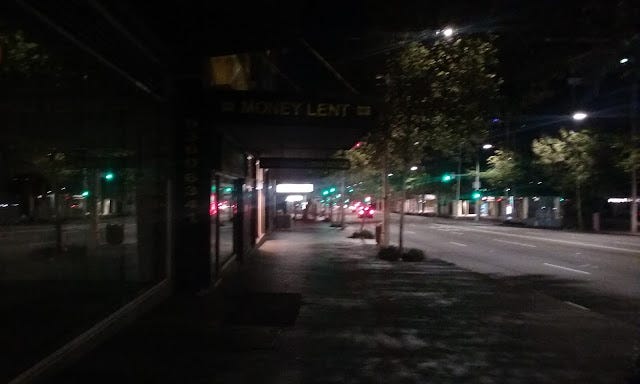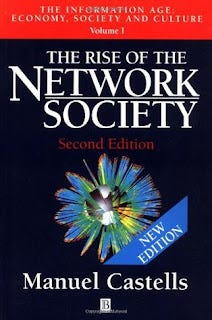
Empty Streets Sydney Picture by John Stapleton
Now then, there was a time for huddling in doorways, bewildered at what had happened, cursed, cast out. There was a time for all things and that time was now. People had been forecasting the end of the world for millenia, but never had there been so many marauding sects predicting that these were The End of Days; that the apocalypse was upon us. Australia was a very long way from the centre of things, in a galaxy far far away as the present hype for Starwars went, but these were crucial things which could not be postponed. Time out of mind. A distant shore. A wan hope. The voices of vanquished tribes.
If there was any way to bring it all back; any way to find comfort in an arid heart, any way to find the bubble of family to fill the days, he would have done it. To sink and die in the ordinary. To never know fear again. To never attract attention. These little extinctions masqueraded as peace. He was fully formed and barely begun. Skills atrophied when they were not used. There was a price for invisibility. One needed to mix, But he did not mix. Come out and play, they beckoned, but he would not. He did not know who to trust, so he took on the old maxim: Trust No One.
Old plaintiffs pleaded their case. They were so human, even when disembodied. There would be a reckoning, but whether he was prepared to pay the price was a different question. Another symbol, another disintegration, another curly little corner in an unsympathetic place. He found a small pocket, almost a grotto, where the powerplants surrounded him and the high blast furnaces provided more energy than they could possibly need. Sparked, sparked. A mine of information. A swirly start. A time inbetween. The places in between.
In reality it was a bohemian suburb; one of those people liked to call a community, although that word in istelf was almost always a misnomer. Television, if nothing else, ensured that people lived more isolated lives than they had ever done before, were less interested in their neighbours, less caring of each other. Cruelty passed for cruelty. Indifference was a national trait. Everything came swriling up and passed. He would be profoundly moved. If only he could be moved. "We have seen too much," he said to a dapper friend as they watched the antics at Stonehenge, the marauding eyes. Everyone on the hunt.
"It was different in my day," he said. "We weren't out looking for sex. Sex was everywhere."
But now these men were different, seeking their mini-deaths in the bodies of others. Just like that they would be gone, enfolded by the night and the passing of time; and soon enough there would be another generation, eyes darting.
THE BIGGER STORY:
Islamic State threatens to destroy Saudi prisons after executions
ReutersJanuary 6, 2016, 7:01 pm

Islamic State flags flutter on the Mullah Abdullah bridge in southern Kirkuk September 29, 2014. REUTERS/Ako Rasheed
RIYADH (Reuters) - Islamic State threatened to destroy Saudi Arabian prisons holding jihadists after Riyadh's execution of 47 people including 43 convicted al Qaeda militants.
The militant group, which has claimed responsibility for attacks in the kingdom and stepped up operations in neighbouring Yemen, singled out the al-Ha'ir and Tarfiya prisons where many al Qaeda and Islamic State supporters have been detained.
"The Islamic State always seeks to free prisoners, but we calculate that the ending of the issues of prisoners will not happen except with the eradication of the rule of tyrants, and then destroying their prisons and razing them to the ground," it said in an article posted online on Tuesday.
An Islamic State supporter killed himself in a car bomb at a checkpoint outside Ha'ir prison near Riyadh in July.
While Islamic State and al Qaeda are rivals who have condemned each other on ideological grounds, they are both united in enmity towards Saudi Arabia, which has declared them terrorist groups and locked up thousands of their supporters.
Riyadh's mass execution on Saturday included four Shi'ite Muslims, among them prominent cleric Nimr al-Nimr, a move that heightened sectarian tensions with Shi'ite power Iran. But analysts say it was mostly meant as a message to militant Sunnis.
Islamic State has claimed responsibility for a series of bombings and shootings in Saudi Arabia since Nov. 2014 that have killed more than 50 people, most of them Shi'ites but also more than 15 members of the security forces.
Saudi security officials say the group's supporters inside Saudi Arabia mainly act independently, depending on Islamic State for only limited logistical help and advice, making them harder to detect, but also less capable of attacks on well protected targets.
Al Qaeda in the Arabian Peninsula (AQAP) threatened in December to "shed the blood of the soldiers of Al Saud" if its members were executed.
AQAP is the Yemen-based wing of the global militant movement and was formed by local jihadists and veterans of al Qaeda's earlier uprising in Saudi Arabia from 2003-06, for participation in which most of those executed on Saturday were convicted.
(Reporting by Ahmed Tolba in Cairo and Yara Bayoumy in Dubai; Writing by Angus McDowall; Editing by Catherine Evans and Andrew Heavens)
FEATURED BOOK:

Click to Read More

iPhone, iPad, iPod Touch and Mac

Free Delivery Worldwide

Signs and portents are everywhere, disturbance everywhere. With post-apocalyptic imagery now entrenched in popular culture, and all the major faiths prophesying that mankind has reached "The End of Days", fantastical theories abound on the origins of the internet; that it was an advanced technology gifted across time and space in order to save an emerging race known as humans from an impending apocalypse by allowing the cleverest minds on the planet to aggregate. Whatever the pure truth, perhaps only the Gods will ever know. But there is no doubt the Rise of Islamic State has been paralleled by the Rise of the Network Society. The single most brilliant philosopher and anthropologist in the field has been Spanish sociologist Manuel Castells. His book The Rise of the Network Society was the first in a string of books documenting the economic and social dynamics of the information age.



